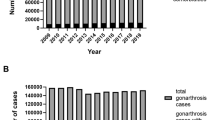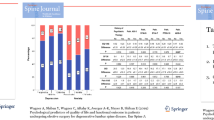Abstract
Purpose
At present only a small number of studies have investigated psychiatric comorbidity in disc surgery patients. Objectives of this study are (1) to examine the prevalence rate of comorbid affective, anxiety, and substance-related disorders in nucleotomy patients in comparison to the German general population and (2) to investigate associations between psychiatric comorbidity and socio-demographic and illness-related characteristics.
Methods
The study refers to 349 consecutive disc surgery patients (response rate 87%) between the age of 18 and 55 years. The final study sample consists of 239 lumbar and 66 cervical nucleotomy patients. Face-to-face interviews were conducted approximately 3.45 days (SD 3.170) after disc surgery, during hospital stay. Psychiatric comorbidity was assessed by means of the Composite International Diagnostic Interview (CIDI-DIA-X). The corresponding data of the German general population were derived from the German National Health Interview and Examination Survey (GHS).
Results
12-Month prevalence rates of any affective, anxiety or substance-related disorders range between 33.7% in cervical and 23.5% in lumbar disc surgery patients. Four-week prevalence rates of any affective, anxiety or substance disorder vary between 13.2% in cervical and 14.0% in lumbar nucleotomy patients. Disc surgery patients suffer more often from affective disorders and illicit substance abuse than the general population. Significant associations were found between psychiatric comorbidity and gender, as well as pain intensity.
Conclusions
Disc surgery patients show a higher risk to suffer from mental disorders than the general population. The assessment of psychiatric distress and the assistance by mental health professionals should be considered during hospital and rehabilitation treatment.
Similar content being viewed by others
References
Krämer J (1994) Bandscheibenbedingte Erkrankungen. Thieme, Stuttgart
Kast E, Antoniadis G, Richter H-P (2000) Epidemiologie von Bandscheibenoperationen in der Bundesrepublik Deutschland. Zentralbl Neurochir 61:22–25
Davis H (1994) Increasing rates of cervical and lumbar spine surgery in the United States, 1979–1990. Spine 19:1117–1124
Wang MC, Kreuter W, Wolfla CE, Maiman DJ, Deyo RA (2009) Trends and variations in cervical spine surgery in the United States: medicare beneficiaries, 1992 to 2005. Spine 34:955–961
Krämer J (2006) Bandscheibenbedingte Erkrankungen––Ursachen, Diagnose, Behandlung, Vorbeugung, Begutachtung. Georg Thieme Verlag KG, Stuttgart
Zieger M, Schwarz R, Konig HH, Harter M, Riedel-Heller SG (2010) Depression and anxiety in patients undergoing herniated disc surgery: relevant but underresearched––a systematic review. Cen Eur Neurosurg 71:26–34
Taylor RE, Creed F, Hughes D (1997) Relation between psychiatric disorder and abnormal illness behaviour in patients undergoing operations for cervical discectomy. J Neurol Neurosurg Psychiatry 63:169–174
Arpino L, Iavarone A, Parlato C, Moraci A (2004) Prognostic role of depression after lumbar disc surgery. Neurol Sci 25:145–147
Basler HD, Zimmer C (1997) Does disphoric mood really predict the outcome of lumbar spine surgery? Methodological pitfalls in psychological research. Eur J Pain 1:197–205
Graver V, Ljunggren AE, Malt UF, Loeb M, Haaland AK, Magnaes B, Lie H (1995) Can psychological traits predict the outcome of lumbar disc surgery when anamnestic and psychological risk factors are controlled for? Results of a prospective cohort study. J Psychosom Res 39:465–476
Häkkinen A, Ylinen J, Kautiainen H, Airaksinen O, Herno A, Tarvainen U, Kiviranta I (2003) Pain, trunk muscle strength, spine mobility and disability following lumbar disc surgery. J Rehabil Med 35:236–240
König HH, Luppa M, Riedel-Heller S (2010) The costs of depression and the cost-effectiveness of treatment. Psychiatr Prax 37:213–215
Glaesmer H, Kallert TW, Brahler E, Hofmeister D, Gunzelmann T (2010) The prevalence of depressive symptomatology in the german elderly population and the impact of methodical aspects on the identified prevalence. Psychiatr Prax 37:71–77
World Health Organisation (1991) International Classification of Diseases (ICD-10). World Health Organization, Geneva
American Psychiatric Association (1994) Diagnostic and statistical manual of mental disorders DSM-IV. American Psychiatric Press, Washington, DC
Serrano-Blanco A, Palao DJ, Luciano JV, Pinto-Meza A, Lujan L, Fernandez A, Roura P, Bertsch J, Mercader M, Haro JM (2010) Prevalence of mental disorders in primary care: results from the diagnosis and treatment of mental disorders in primary care study (DASMAP). Soc Psychiatry Psychiatr Epidemiol 45:201–210
Wancata J, Meise U (2009) Research instruments in social psychiatry research. Psychiatr Prax 36:368–372
Jacobi F, Wittchen H-U, Hölting C, Höfler M, Pfister H, Müller N, Lieb R (2004) Prevalence, co-morbidity and correlates of mental disorders in the general population: results from the German Health Interview and Examination Survey (GHS). Psychol Med 34:597–611
Wittchen H-U, Müller N, Pfister H, Winter S, Schmidtkunz B (1999) Affektive, somatoforme und Angststörungen in Deutschland - Erste Ergebnisse des bundesweiten Zusatzsurveys “Psychische Störungen”. Gesundheitswesen 61:S216–S222
Wittchen H-U, Pfister E (1997) Instruktionsmanual zur Durchführung von DIA-X Interviews. Swets & Zeitlinger B.V, Swets Test Services, Frankfurt
Härter M, Hahn D, Baumeister H, Reuter K, Wunsch A, Bengel J (2004) Komorbidität bei Patienten mit muskuloskelettalen und kardiovaskulären Erkrankungen - Prävalenzen, Diagnosen und Konsequenzen für die Rehabilitation. J Public Health 12:162–167
Härter M, Reuter K, Gross-Hardt M, Bengel J (2001) Screening for anxiety, depressive and somatoform disorders in rehabilitation––validity of HADS and GHQ-12 in patients with musculoskeletal disease. Disabil Rehabil 23:737–744
Härter M, Reuter K, Weisser B, Schretzmann B, Aschenbrenner B, Bengel J (2002) A descriptive study of psychiatric disorders and psychosocial burden in rehabilitation patients with musculoskeletal diseases. Arch Phys Med Rehabil 83:461–468
Potter JS, Prather K, Kropp F, Byrne M, Sullivan CR, Mohamedi N, Copersino ML, Weiss RD (2010) A method to diagnose opioid dependence resulting from heroin versus prescription opioids using the Composite International Diagnostic Interview. Contemp Clin Trials 31:185–188
Wilson EB (1927) Probable inference, the law of succession, and statistical inference. J Am Stat Assoc 22:209–212
Härter M, Woll S, Reuter K, Wunsch A, Bengel J (2004) Recognition of psychiatric disorders in musculoskeletal and cardiovasular rehabilitation patients. Arch Phys Med Rehabil 85:1192–1197
Polatin PB, Kinney RK, Gatchel RJ, Lillo E, Mayer TG (1993) Psychiatric illness and chronic low-back pain. The mind and the spine––which goes first? Spine 18:66–71
Nickinson RS, Board TN, Kay PR (2009) Post-operative anxiety and depression levels in orthopaedic surgery: a study of 56 patients undergoing hip or knee arthroplasty. J Eval Clin Pract 15:307–310
Sullivan M, Tanzer M, Stanish W, Fallaha M, Keefe FJ, Simmonds M, Dunbar M (2009) Psychological determinants of problematic outcomes following total knee arthroplasty. Pain 143:123–129
Brander V, Gondek S, Martin E, Stulberg SD (2007) Pain and depression influence outcome 5 years after knee replacement surgery. Clin Orthop Relat Res 464:21–26
Häkkinen A, Ylinen J, Kautiainen H, Airaksinen O, Herno A, Kiviranta I (2003) Does the outcome 2 months after lumbar disc surgery predict the outcome 12 months later. Disabil Rehabil 25:968–972
Penta M, Fraser RD (1997) Anterior lumbar interbody fusion. A minimum 10-year follow-up. Spine 22:2429–2434
Junge A, Dvorak J, Ahrens S (1995) Predictors of bad and good outcomes of lumbar disc surgery. A prospective clinical study with recommendations for screening to avoid bad outcomes. Spine 20:460–468
Jarvik JG, Hollingworth W, Heagerty PJ, Haynor DR, Boyko EJ, Deyo RA (2005) Three-year incedence of low back pain in an initially asymptomatic cohort. Clinical and imaging risk factors. Spine 30:1541–1548
Beesdo K, Jacobi F, Hoyer J, Low NC, Hofler M, Wittchen HU (2010) Pain associated with specific anxiety and depressive disorders in a nationally representative population sample. Soc Psychiatry Psychiatr Epidemiol 45:89–104
Schneider S, Mohnen SM, Schiltenwolf M, Rau C (2007) Comorbidity of low back pain: representative outcomes of a national health study in the Federal Republic of Germany. Eur J Pain 11:387–397
Miller S, Lo C, Gagliese L, Hales S, Rydall A, Zimmermann C, Li M, Rodin G (2010) Patterns of depression in cancer patients: an indirect test of gender-specific vulnerabilities to depression. Soc Psychiatry Psychiatr Epidemiol (Epub ahead of print)
Baumeister H, Harter M (2007) Prevalence of mental disorders based on general population surveys. Soc Psychiatry Psychiatr Epidemiol 42:537–546
Mannion AF, Elfering A (2006) Predictors of surgical outcome and their assessment. Eur Spine J 15:S93–S108
Trief PM, Grant W, Fredrickson B (2000) A prospective study of psychological predictors of lumbar surgery outcome. Spine 25:2616–2621
Bringmann H, Singer S, Hockel M, Stolzenburg JU, Krauss O, Schwarz R (2008) Longitudinal analysis of psychiatric morbidity in cancer patients. Onkologie 31:343–344
Vahdaninia M, Omidvari S, Montazeri A (2010) What do predict anxiety and depression in breast cancer patients? A follow-up study. Soc Psychiatry Psychiatr Epidemiol 45:355–361
Kühn-Mengel H (2008) Ausbau der Patientenberatung: bei psychischen Erkrankungen von besonderer Bedeutung. Psychiatr Prax 35:107
Acknowledgments
This publication has been supported by the Department of Neurosurgery of the Klinikum St. Georg gGmbH Leipzig, by the Department of Neurosurgery of the University of Leipzig and by the Department of Neurosurgery of the Berufsgenossenschaftliche Kliniken Bergmannstrost Halle (Saale). This publication was funded by the Deutsche Rentenversicherung Bund (Project: Psychiatric comorbidity and early retirement in patients with somatic diseases. Reference number: 8011-106-31/31.81) and has received ethics committee approval.
Conflict of interest
The authors declare that they have no conflict of interest.
Author information
Authors and Affiliations
Corresponding author
Rights and permissions
About this article
Cite this article
Zieger, M., Luppa, M., Matschinger, H. et al. Affective, anxiety, and substance-related disorders in patients undergoing herniated disc surgery. Soc Psychiatry Psychiatr Epidemiol 46, 1181–1190 (2011). https://doi.org/10.1007/s00127-010-0283-2
Received:
Accepted:
Published:
Issue Date:
DOI: https://doi.org/10.1007/s00127-010-0283-2




